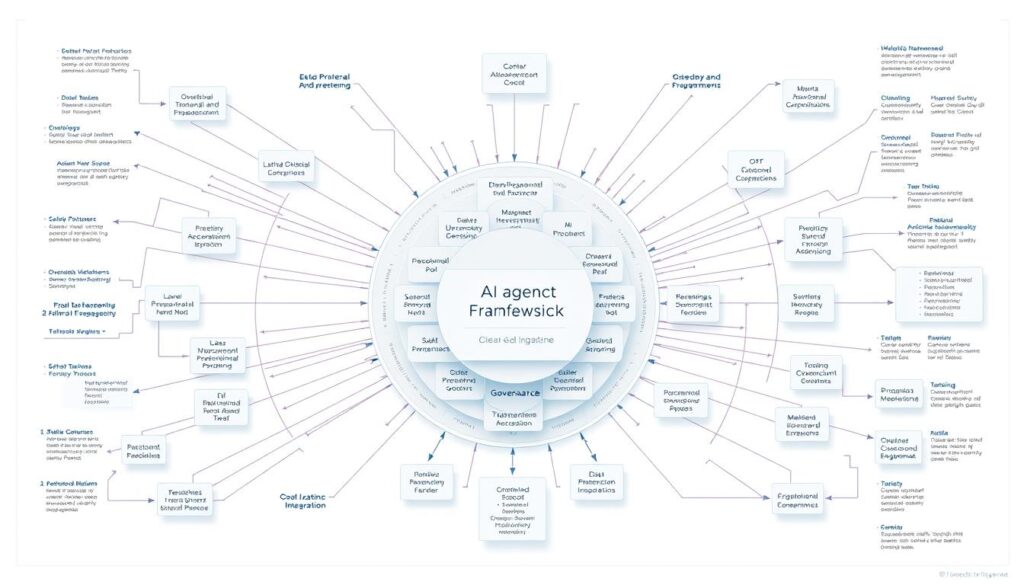By 2028, autonomous systems will handle 15% of daily operational decisions—a leap from near-zero adoption today. This shift, driven by advanced machine learning models, introduces both efficiency gains and critical vulnerabilities. Analysts warn that 25% of enterprise security breaches could soon stem from poorly managed autonomous tools, creating urgent challenges for modern businesses.
These systems operate independently across platforms like Salesforce and Google Cloud, interpreting data to execute tasks without human oversight. While they streamline workflows, their complexity demands more than basic registration protocols. Effective management requires granular control over data permissions, system integrations, and behavioral boundaries.
Traditional oversight methods struggle to address risks posed by self-adapting technologies. A recent study of leading solutions reveals gaps in accountability frameworks, particularly when third-party tools interact with sensitive corporate ecosystems. Without robust safeguards, organizations risk compliance failures and operational disruptions.
Key Takeaways
- Autonomous decision-making systems will influence 15% of daily business operations by 2028
- 25% of enterprise security incidents may originate from unregulated system interactions
- Cross-platform compatibility creates unique governance challenges for IT teams
- Behavioral monitoring must evolve to address self-modifying technologies
- Third-party integrations require stricter compliance verification processes
Introduction to AI Agents and Their Impact

Modern enterprises now deploy self-operating software that learns from data patterns and executes actions across digital ecosystems. These tools manage everything from inventory flows to personalized marketing campaigns, fundamentally altering how organizations approach operational strategies.
Defining Autonomous Software Capabilities
Sophisticated programs leverage machine learning models to perform tasks traditionally requiring human analysis. In customer support, they resolve 73% of routine inquiries through natural language processing, reducing resolution times by 58% according to Zendesk benchmarks.
Three core functions define their operational value:
- Predictive analysis: Anticipating supply chain disruptions 14 days in advance
- Adaptive execution: Modifying marketing bids in real-time based on conversion data
- Cross-platform integration: Synchronizing HR platforms with payroll systems
Operational Transformation Through Automation
Retail giants like Target now use these solutions to optimize stock levels across 1,900+ stores, cutting overstock costs by 19% annually. Marketing teams achieve 34% higher click-through rates through algorithm-driven ad placements that analyze consumer behavior across social platforms.
Financial institutions demonstrate another critical application. JPMorgan’s COiN platform reviews 12,000 annual contracts in seconds – work that previously consumed 360,000 staff hours. This shift enables human experts to focus on complex regulatory compliance and strategic planning.
Current Trends in AI Agent Development and Deployment

The landscape of enterprise technology is shifting as 78% of businesses now implement pre-built automation tools. These solutions handle tasks ranging from inventory forecasting to customer interaction analysis, reshaping operational models across industries.
Key Statistics and Market Projections
Market analysts project a 40% compound annual growth rate for ready-to-deploy solutions through 2027. Retail leaders report 22% faster decision cycles using predictive analytics tools, while manufacturers achieve 18% cost reductions through automated supply chain optimizers.
Three critical patterns emerge:
- 64% of enterprises prioritize vendor-provided tools over custom builds
- Integration timelines shrink from 9 months to 11 weeks average
- 43% of IT budgets now allocated to configuration management
Integrating Intelligent Automation into Enterprise Ecosystems
Major platforms like SAP and Salesforce now host 12-15 connected automation tools per client instance. This creates complex data governance challenges:
“Organizations managing 50+ integrated solutions experience 3x more configuration errors than those with centralized systems”
Financial institutions demonstrate successful deployment strategies. Bank of America’s cash flow predictors integrate with legacy mainframes through API layers, maintaining compliance while improving forecast accuracy by 31%.
Effective implementation requires:
- Granular access controls for cross-platform data flows
- Real-time performance monitoring dashboards
- Automated version control systems
Recent analysis of leading solutions reveals 68% require additional security protocols when interfacing with cloud infrastructures. This underscores the need for robust deployment frameworks that balance innovation with operational safety.
AI agent trust & governance web: A Critical Framework

Organizations face mounting pressure to manage self-learning systems that influence critical operations. These technologies process sensitive information while adapting to dynamic environments, demanding new oversight methods. A structured approach prevents costly errors while maintaining operational agility.
Understanding Governance Structures and Frameworks
Modern oversight systems require layered controls addressing three core challenges:
- Lifecycle management from development to retirement
- Real-time behavior monitoring across platforms
- Cross-functional accountability protocols
Financial institutions exemplify effective implementation. Recent studies show organizations with mature frameworks reduce compliance incidents by 47% through automated audit trails. Decision boundaries must align with both technical capabilities and regulatory expectations.
Balancing Innovation with Regulatory Compliance
Progressive organizations deploy adaptive strategies that satisfy stakeholders while meeting legal requirements:
| Consideration | Traditional Approach | Modern Solution |
|---|---|---|
| Deployment Speed | 6-9 month review cycles | Automated compliance checks |
| Decision Transparency | Manual documentation | Real-time activity logs |
| System Updates | Quarterly audits | Continuous risk scoring |
This dual focus enables rapid iteration without compromising oversight. Teams maintain innovation velocity through pre-approved development sandboxes and scenario testing environments.
Data Privacy and Compliance in AI Systems

Organizations managing automated decision-making tools face unprecedented scrutiny over information handling practices. The EU AI Act’s 2024 implementation reshapes global standards, creating legal obligations for any entity processing European citizen data.
Addressing Regulatory Standards and the EU AI Act
Europe’s landmark legislation categorizes technologies into four risk tiers, with high-risk systems in sectors like healthcare facing stringent rules. These tools must maintain audit trails, enable human intervention points, and undergo third-party assessments. Financial penalties reach 3% of global revenue for violations, incentivizing proactive compliance measures.
Platforms like OneTrust help organizations map data flows across cloud environments while automating documentation processes. This proves critical for systems handling biometric or employment-related information, where bias detection protocols are mandatory.
Strategies for Robust Data Protection and Privacy
Effective frameworks combine technical safeguards with operational policies. Data minimization techniques limit information collection to essential parameters, reducing exposure risks. Encryption standards and access controls prevent unauthorized use during cross-platform transfers.
Leading enterprises adopt privacy-by-design principles, embedding protective measures during development phases. Regular impact assessments identify vulnerabilities in real-time decision algorithms, ensuring alignment with evolving regulations like GDPR. Tools from specialized providers streamline consent management while maintaining operational efficiency.
Risk Management and Oversight of Autonomous AI Agents
https://www.youtube.com/watch?v=XdhG_sezQAo
Self-learning tools now influence critical operations in 63% of Fortune 500 companies, yet 42% lack formal protocols for managing their decision pathways. This gap creates vulnerabilities where autonomous actions diverge from organizational goals.
Unsanctioned Automation Threats
Shadow operations emerge when departments deploy solutions without central approval. A 2024 TechTarget survey found these unmonitored systems cause 38% of compliance violations in financial sectors. Common issues include:
| Risk Category | Traditional Oversight | Modern Approach |
|---|---|---|
| Decision Transparency | Quarterly audits | Real-time activity logs |
| System Updates | Manual verification | Automated version control |
| Access Management | Role-based permissions | Behavior-triggered restrictions |
Balancing Autonomy with Control
Effective frameworks require intervention protocols that preserve efficiency while preventing harmful outcomes. “Operators need kill switches that halt processes without disrupting entire workflows,” advises a Gartner report on autonomous system management.
Leading enterprises implement layered approval systems. Critical decisions route through human validators, while routine tasks operate independently. Platforms like secure AI tools enable this balance through customizable thresholds and exception alerts.
Regular impact assessments identify emerging threats before they escalate. These evaluations analyze decision patterns across operational environments, ensuring alignment with evolving business objectives and regulatory standards.
Leveraging Advanced Technology for AI Governance
https://www.youtube.com/watch?v=9PEFNHsyjPM
Specialized software now addresses the growing complexity of managing self-learning systems. Enterprise leaders increasingly adopt purpose-built platforms to maintain visibility across distributed operations while meeting compliance requirements.
Modern Tools for Systematic Management
Platforms like Collibra and OneTrust deliver integrated solutions for tracking system behaviors and decision patterns. These tools provide:
- Automated documentation of development processes
- Real-time alerts for unauthorized data access
- Cross-platform performance dashboards
“Organizations using governance platforms resolve compliance issues 63% faster than those relying on manual processes”
| Capability | Collibra | OneTrust |
|---|---|---|
| Lifecycle Tracking | Full audit trails | Automated workflows |
| Risk Detection | Bias identification | Privacy impact assessments |
| Scalability | Multi-cloud support | Global regulation mapping |
Collibra empowers oversight teams to map system interactions across hybrid infrastructures. Its analytics engine flags deviations from operational guidelines, enabling proactive corrections. For companies exploring open-source platforms, these tools ensure compatibility with existing governance frameworks.
OneTrust streamlines compliance through automated documentation and risk scoring. Financial institutions using its modules reduced audit preparation time by 41% last year. The platform’s centralized interface gives teams actionable insights without requiring deep technical expertise.
Building Effective Governance Frameworks
Effective oversight of autonomous systems requires foundational pillars that adapt to evolving operational demands. Organizations must implement structured approaches combining policy development with technical safeguards to maintain accountability across distributed environments.
Establishing Clear Policies and Operational Guidelines
Access controls form the first line of defense in multi-agent environments. Restricting permissions through role-based protocols prevents unauthorized data interactions. Data anonymization techniques further reduce exposure risks during cross-platform exchanges.
Operational playbooks should define escalation protocols for critical decisions. These guidelines ensure human oversight triggers when systems encounter unverified data patterns or breach predefined thresholds.
Automated Monitoring and Continuous Risk Assessments
Data loss prevention (DLP) tools now offer real-time tracking of information flows across cloud ecosystems. Advanced solutions flag anomalies using behavioral analysis, automatically pausing processes until human validators review flagged activities.
Regular audits assess framework performance through stress-testing scenarios. Organizations using strategic framework design principles report 52% faster incident resolution by aligning technical controls with business objectives. This dual focus strengthens compliance while preserving operational agility.







